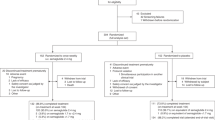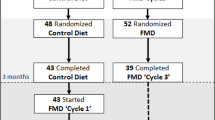Abstract
Background/Objectives:
Flax and Salba-chia seeds have risen in popularity owing to their favorable nutrient composition, including a high fiber content. Despite having comparable nutritional profiles, preliminary observations suggest differences in gelling properties, an attribute that may alter the kinetics of food digestion. Thus, we compared the effect of two seeds on postprandial glycemia and satiety scores.
Subjects/Methods:
Fifteen healthy participants (M/F: 5/10; age: 23.9±3 years; BMI: 22.2±0.8 kg/m2) were randomized to receive a 50 g glucose challenge, alone or supplemented with either 25 g ground Salba-chia or 31.5 g flax, on three separate occasions. Blood glucose samples and satiety ratings were collected at fasting and over 2-h postprandially. In addition, in vitro viscosity of the beverages was assessed utilizing standard rheological methodology.
Results:
Both Salba-chia and flax reduced blood glucose area under the curve over 120 min by 82.5±19.7 mmol/l (P<0.001) and 60.0±19.7 mmol/l (P=0.014), respectively, relative to a glucose control. Salba-chia reduced peak glucose (−0.64±0.24 mmol/l; P=0.030) and increased time to peak (11.3±3.8 min; P=0.015) compared with flax. Salba-chia significantly reduced the mean ratings of desire to eat (−7±2 mm; P=0.005), prospective consumption (−7±2 mm; P=0.010) and overall appetite score (−6±2 mm; P=0.012), when compared with flax. The viscosity of Salba-chia, flax and control was 49.9, 2.5, and 0.002 Pa·s, respectively.
Conclusions:
Despite the similarities in nutritional composition, Salba-chia appears to have the ability to convert glucose into a slow-release carbohydrate and affect satiety to a greater extent than flax, possibly due to the higher fiber viscosity. Incorporation of either flax or Salba-chia into the diet may be beneficial, although use of Salba-chia may confer additional benefit.
This is a preview of subscription content, access via your institution
Access options
Subscribe to this journal
Receive 12 print issues and online access
$259.00 per year
only $21.58 per issue
Buy this article
- Purchase on Springer Link
- Instant access to full article PDF
Prices may be subject to local taxes which are calculated during checkout

Similar content being viewed by others
References
Dietary Guidelines Advisory Committee, US Department of Agriculture. Scientific report of the 2015 dietary guidelines advisory committee; 2015.
Eat Right Ontario. Your challenge—choose nuts and seeds more often! 2015.
US Department of Agriculture, Agricultural Research Service, Nutrient Data Laboratory. USDA national nutrient database for standard reference, release 25: nutrient data for chia seeds; 2012.
US Department of Agriculture, Agricultural Research Service, Nutrient Data Laboratory. USDA national nutrient database for standard reference, release 25: nutrient data for flaxseeds; 2012.
Ho H, Lee AS, Jovanovski E, Jenkins AL, Desouza R, Vuksan V . Effect of whole and ground Salba seeds (Salvia Hispanica L.) on postprandial glycemia in healthy volunteers: a randomized controlled, dose-response trial. Eur J Clin Nutr 2013; 67: 786–788.
Vuksan V, Jenkins AL, Dias AG, Lee AS, Jovanovski E, Rogovik AL et al. Reduction in postprandial glucose excursion and prolongation of satiety: possible explanation of the long-term effects of whole grain Salba (Salvia Hispanica L.). Eur J Clin Nutr 2010; 64: 436–438.
Vuksan V, Whitham D, Sievenpiper JL, Jenkins AL, Rogovik AL, Bazinet RP et al. Supplementation of conventional therapy with the novel grain Salba (Salvia hispanica L.) improves major and emerging cardiovascular risk factors in type 2 diabetes: results of a randomized controlled trial. Diabetes Care 2007; 30: 2804–2810.
Jenkins DJ, Kendall CW, Vidgen E, Agarwal S, Rao AV, Rosenberg RS et al. Health aspects of partially defatted flaxseed, including effects on serum lipids, oxidative measures, and ex vivo androgen and progestin activity: a controlled crossover trial. Am J Clin Nutr 1999; 69: 395–402.
Cunnane SC, Ganguli S, Menard C, Liede AC, Hamadeh MJ, Chen ZY et al. High alpha-linolenic acid flaxseed (Linum usitatissimum: some nutritional properties in humans. Br J Nutr 1993; 69: 443–453.
Vuksan V, Rogovik AL, Jovanovski E, Jenkins AL . Fiber facts: benefits and recommendations for individuals with type 2 diabetes. Curr Diab Rep 2009; 9: 405–411.
Coorey R, Tjoe A, Jayasena V . Gelling properties of chia seed and flour. J Food Sci 2014; 79: E859–E866.
Kristensen M, Savorani F, Christensen S, Engelsen SB, Bugel S, Toubro S et al. Flaxseed dietary fibers suppress postprandial lipemia and appetite sensation in young men. Nutr Metab Cardiovasc Dis 2013; 23: 136–143.
Kaewmanee T, Bagnasco L, Benjakul S, Lanteri S, Morelli CF, Speranza G et al. Characterisation of mucilages extracted from seven Italian cultivars of flax. Food Chem 2014; 148: 60–69.
Cunnane SC, Hamadeh MJ, Liede AC, Thompson LU, Wolever TM, Jenkins DJ . Nutritional attributes of traditional flaxseed in healthy young adults. Am J Clin Nutr 1995; 61: 62–68.
Vuksan V, Panahi S, Lyon M, Rogovik AL, Jenkins AL, Leiter LA . Viscosity of fiber preloads affects food intake in adolescents. Nutr Metab Cardiovasc Dis 2009; 19: 498–503.
Flint A, Raben A, Blundell JE, Astrup A . Reproducibility, power and validity of visual analogue scales in assessment of appetite sensations in single test meal studies. Int J Obes Relat Metab Disord 2000; 24: 38–48.
Jenkins DJ, Wolever TM, Leeds AR, Gassull MA, Haisman P, Dilawari J et al. Dietary fibres, fibre analogues, and glucose tolerance: importance of viscosity. Br Med J 1978; 1: 1392–1394.
Timilsena YP, Adhikari R, Kasapis S, Adhikari B . Rheological and microstructural properties of the chia seed polysaccharide. Int J Biol Macromol 2015; 81: 991–999.
Khouryieh HA, Herald TJ, Aramouni F, Alavi S . Intrinsic viscosity and viscoelastic properties of xanthan/guar mixtures in dilute solutions: effect of salt concentration on the polymer interactions. Food Res Int 2007; 40: 883–893.
Higiro J, Herald TJ, Alavi S . Rheological study of xanthan and locust bean gum interaction in dilute solution. Food Res Int 2006; 39: 165–175.
Pavlov A, Paynel F, Rihouey C, Porokhovinova E, Brutch N, Morvan C . Variability of seed traits and properties of soluble mucilages in lines of the flax genetic collection of Vavilov Institute. Plant Physiol Biochem 2014; 80: 348–361.
Naran R, Chen G, Carpita NC . Novel rhamnogalacturonan I and arabinoxylan polysaccharides of flax seed mucilage. Plant Physiol 2008; 148: 132–141.
Lin KY, Daniel JR, Whistler RL . Structure of chia seed polysaccharide exudate. Carbohydr Polym 1994; 23: 13–18.
Ellis PR, Dawoud FM, Morris ER . Blood glucose, plasma insulin and sensory responses to guar-containing wheat breads: effects of molecular weight and particle size of guar gum. Br J Nutr 1991; 66: 363–379.
Jenkins AL, Jenkins DJ, Wolever TM, Rogovik AL, Jovanovski E, Bozikov V et al. Comparable postprandial glucose reductions with viscous fiber blend enriched biscuits in healthy subjects and patients with diabetes mellitus: acute randomized controlled clinical trial. Croat Med J 2008; 49: 772–782.
Wood PJ, Braaten JT, Scott FW, Riedel KD, Wolynetz MS, Collins MW . Effect of dose and modification of viscous properties of oat gum on plasma glucose and insulin following an oral glucose load. Br J Nutr 1994; 72: 731–743.
Galvao CF, Silva Ton WT, Goncalves Alfenas RC . Addition of dietary fiber sources to shakes reduces postprandial glycemia and alters food intake. Nutr Hosp 2014; 31: 299–306.
Tay J, Thompson CH, Brinkworth GD . Glycemic variability: assessing glycemia differently and the implications for dietary management of diabetes. Annu Rev Nutr 2015; 35: 389–424.
Mattes RD, Rothacker D . Beverage viscosity is inversely related to postprandial hunger in humans. Physiol Behav 2001; 74: 551–557.
Lafond DW, Greaves KA, Maki KC, Leidy HJ, Romsos DR . Effects of two dietary fibers as part of ready-to-eat cereal (RTEC) breakfasts on perceived appetite and gut hormones in overweight women. Nutrients 2015; 7: 1245–1266.
Cohen L, Meira J, Cosendey GM, de Souza AF, Mattos F, Carneiro JR et al. Evaluation of the influence of whole and defatted flaxseed on satiety, glucose, and leptin levels of women in the late postoperative stage of bariatric surgery. Obes Surg 2013; 23: 157–166.
Ibrugger S, Kristensen M, Mikkelsen MS, Astrup A . Flaxseed dietary fiber supplements for suppression of appetite and food intake. Appetite 2012; 58: 490–495.
Ayerza R . The seed's oil content and fatty acid composition of chia (Salvia hispanica L.) var. Iztac 1, grown under six tropical ecosystems conditions. Interciencia 2011; 36: 620–624.
EFSA. Scientific opinion of the panel on dietetic products nutrition and allergies on a request from the European Commission on the safety of 'Chia seed (Salvia hispanica and ground whole Chia seed' as a food ingredient. The EFSA Journal 2009; 996: 1–26.
Ayerza R, Coates W . Dietary levels of chia: influence on yolk cholesterol, lipid content and fatty acid composition for two strains of hens. Poult Sci 2000; 79: 724–739.
Ayerza R . The seed's protein and oil content, fatty acid composition, and growing cycle length of a single genotype of chia (Salvia hispanica L.) as affected by environmental factors. J Oleo Sci 2009; 58: 347–354.
Oomah BD, Mazza G . Compositional changes during commercial processing of flaxseed. Ind Crops Prod 1998; 9: 29–37.
Oomah BD, Kenaschuk EO, Cui W, Mazza G . Variation in the composition of water-soluble polysaccharides in flaxseed. J Agric Food Chem 1995; 43: 1484–1488.
Daun JK, Barthet VJ, Chornick TL, Duguid S. Structure, composition, and variety development of flaxseed. In: Thompson LU, Cunnane SC (eds). Flaxseed in Human Nutrition, 2nd edn. AOCS Press: Champaign, IL, 2003, pp 1–40.
Marciani L, Gowland PA, Spiller RC, Manoj P, Moore RJ, Young P et al. Effect of meal viscosity and nutrients on satiety, intragastric dilution, and emptying assessed by MRI. Am J Physiol Gastrointest Liver Physiol 2001; 280: G1227–G1233.
Acknowledgements
Salba Smart, Natural Products (Centennial, CO, USA) provided Salba-chia seeds. The results were partially presented as an abstract at Experimental Biology 2010 (The FASEB Journal. 2008;22:A148), supported by a travel grant received from Salba Corporation, Argentina.
Author information
Authors and Affiliations
Corresponding author
Ethics declarations
Competing interests
V Vuksan acted as a consultant to Salba Corporation, Buena Aires, Argentina (2003–2006), Core Naturals, FL, USA (2007–2008) and received conference travel grants from Salba Smart Natural Products (2008&2010), LLC, Centennial, CO, USA and Source Salba Inc, Toronto, Canada (2008). V Vuksan holds an American (No. 7 326 404 B2) and Canadian (No. 2 410 556) patent for use of viscous fiber blend in diabetes, metabolic syndrome and cholesterol lowering; received a honorarium for scientific advice from InovoBiologic (Calgary, AB, Canada) the producer of viscous fiber blend PGX that is developed based on Vuksan’s patent. V Vuksan was VP and partial owner of Glycemic Index Laboratories (Toronto, ON., Canada) a contract research organization, (2004–2015). A Jenkins is VP and partial owner of Glycemic Index Laboratories (Toronto, ON., Canada) a clinical research organization. All other authors have no conflict of interest to declare.
Rights and permissions
About this article
Cite this article
Vuksan, V., Choleva, L., Jovanovski, E. et al. Comparison of flax (Linum usitatissimum) and Salba-chia (Salvia hispanica L.) seeds on postprandial glycemia and satiety in healthy individuals: a randomized, controlled, crossover study. Eur J Clin Nutr 71, 234–238 (2017). https://doi.org/10.1038/ejcn.2016.148
Received:
Revised:
Accepted:
Published:
Issue Date:
DOI: https://doi.org/10.1038/ejcn.2016.148
This article is cited by
-
The therapeutic potential of chia seeds as medicinal food: a review
Nutrire (2023)
-
Sensory and process optimization of a mango bagasse-based beverage with high fiber content and low glycemic index
Journal of Food Science and Technology (2022)
-
Amelioration of hyperglycemia and hyperlipidemia in a high-fat diet-fed mice by supplementation of a developed optimized polyherbal formulation
3 Biotech (2022)
-
Co-administration of viscous fiber, Salba-chia and ginseng on glycemic management in type 2 diabetes: a double-blind randomized controlled trial
European Journal of Nutrition (2021)
-
Chia (Salvia hispanica)-supplemented diet ameliorates non-alcoholic fatty liver disease and its metabolic abnormalities in humans
Lipids in Health and Disease (2020)



